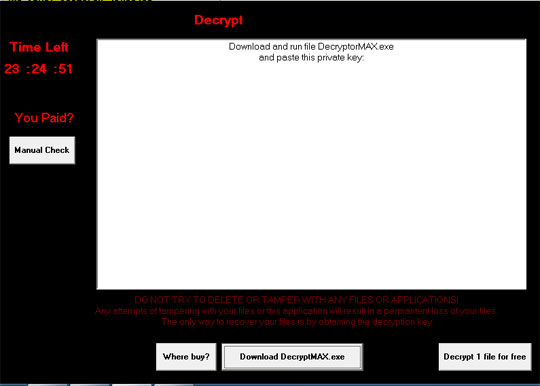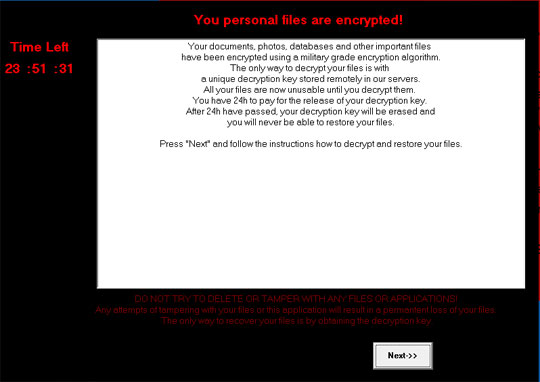Ransom.Win32.CRYPFINI.A
Ransom.CryptInfinite (NORTON); Ransom:Win32/Finicrypt.A (MICROSOFT)
Windows


Threat Type: Ransomware
Destructiveness: No
Encrypted:
In the wild: Yes
OVERVIEW
Downloaded from the Internet
This Ransomware arrives on a system as a file dropped by other malware or as a file downloaded unknowingly by users when visiting malicious sites.
It encrypts files with specific file extensions.
TECHNICAL DETAILS
496,128 bytes
EXE
Yes
27 Nov 2020
Displays message/message boxes, Encrypts files, Connects to URLs/IPs, Terminates processes
Arrival Details
This Ransomware arrives on a system as a file dropped by other malware or as a file downloaded unknowingly by users when visiting malicious sites.
Installation
This Ransomware drops the following copies of itself into the affected system:
- %User Profile%\{Computer name}-{Random Characters}.exe
(Note: %User Profile% is the current user's profile folder, which is usually C:\Documents and Settings\{user name} on Windows 2000(32-bit), XP, and Server 2003(32-bit), or C:\Users\{user name} on Windows Vista, 7, 8, 8.1, 2008(64-bit), 2012(64-bit) and 10(64-bit).)
It drops the following files:
- {Target Drive or Folders}:\ReadDecryptFilesHere.txt
- %User Profile%\z2.bmp
(Note: %User Profile% is the current user's profile folder, which is usually C:\Documents and Settings\{user name} on Windows 2000(32-bit), XP, and Server 2003(32-bit), or C:\Users\{user name} on Windows Vista, 7, 8, 8.1, 2008(64-bit), 2012(64-bit) and 10(64-bit).)
It adds the following processes:
- "%System%\cmd.exe" /k vssadmin.exe Delete Shadows /All /Quiet
- "%System%\cmd.exe" /k bcedit.exe /set {default} recoveryenabled No
- "%System%\cmd.exe" /k bcedit.exe /set {default} bootstatuspolicy ignoreallfailures
(Note: %System% is the Windows system folder, where it usually is C:\Windows\System32 on all Windows operating system versions.)
Autostart Technique
This Ransomware adds the following registry entries to enable its automatic execution at every system startup:
HKEY_CURRENT_USER\Software\Microsoft\
Windows\CurrentVersion\Run
Microsoft corporation = %User Profile%\{Computer name}-{Random Characters}.exe
Other System Modifications
This Ransomware adds the following registry entries:
HKEY_CURRENT_USER\Software\CryptInfinite\
Info
KEY = [Random characters]
HKEY_CURRENT_USER\Software\CryptInfinite\
Info
KEYFREE = [Random characters]
HKEY_CURRENT_USER\Software\CryptInfinite\
Info
1 = 000000
HKEY_CURRENT_USER\Software\CryptInfinite\
Info
c = 23
HKEY_CURRENT_USER\Software\CryptInfinite\
Info
m = 59
HKEY_CURRENT_USER\Software\CryptInfinite\
Info
s = {59,43,41,39}
HKEY_CURRENT_USER\Software\CryptInfinite\
Info
Finish = True
HKEY_CURRENT_USER\Software\CryptInfinite\
Info
FreeFile = {File name of the 10th encrypted file}
HKEY_CURRENT_USER\Software\CryptInfinite\
Files
{Number starting from 1 up to the total number of encrypted files} = {File name of the encrypted file}
It changes the desktop wallpaper by modifying the following registry entries:
HKEY_CURRENT_USER\Control Panel\Desktop
wallpaper = %User Profile%\z2.bmp
Process Termination
This Ransomware terminates the following processes if found running in the affected system's memory:
- msconfig.exe
- rstrui.exe
- tcpview.exe
- procexp.exe
- procmon.exe
- wireshark.exe
- lordPE.exe
- regedit.exe
- cmd.exe
- filemon.exe
- procexp64.exe
Other Details
This Ransomware adds the following registry keys:
HKEY_CURRENT_USER\Software\CryptInfinite
HKEY_CURRENT_USER\Software\CryptInfinite\
Info
HKEY_CURRENT_USER\Software\CryptInfinite\
Files
It does the following:
- Encrypts files within the following drives only:
- Fixed Drive
- Removable Drive
- Network Drive
- Change desktop wallpaper into:

- Drops this text file that serves as a ransom note:

- Connects to the following URL and waits for a response before the malware proceeds to display the ransomnote:
- http://{BLOCKED}i2.onion.direct/lending/bot.php?name={Computer Name}&kod={Random Characters}&pid=2
- Display this following window if successfully established connection from the URL above:
- These buttons does the following:
- "Next->" -> Display another page:

- "Where buy?" -> https://www.paypal-cash.com -> Legitimate Paypal website.
- "Decrypt 1 file for free" -> Restore the 10th encrypted file.
- "Manual Check" -> Display another message and button:

- "Download DecryptMax.exe" -> http://www.sendspace.com/file/{BLOCKED}n
- "Next->" -> Display another page:
Ransomware Routine
This Ransomware encrypts files with the following extensions:
- .yuv
- .php
- .html
- .jsp
- .xlsx
- .xlsm
- .xlsb
- .XLS
- .xlr
- .XLK
- .X3F
- .wps
- .wpd
- .wmv
- .wma
- .WB2
- .wav
- .vob
- .vmxf
- .vmx
- .vmsd
- .vmdk
- .vhdx
- .vhd
- .vdi
- .vbox
- .tlg
- .thm
- .tga
- .tex
- .swf
- .svg
- .stm
- .srw
- .srt
- .SRF
- .SR2
- .sql
- .sav
- .safe
- .rwl
- .rw2
- .rvt
- .rtf
- .rm
- .RAW
- .raf
- .R3D
- .qed
- .qcow2
- .qcow
- .qby
- .qbx
- .qbw
- .qbr
- .qbm
- .qbb
- .qba
- .py
- .pwm
- .PTX
- .pst
- .PSD
- .ps
- .pptx
- .PPTM
- .ppt
- .pps
- .png
- .pl
- .pif
- .pfx
- .pem
- .PEF
- .PDD
- .pdb
- .pct
- .pas
- .pab
- .P7C
- .p7b
- .p12
- .ost
- .orf
- .ogg
- .odt
- .ods
- .ODP
- .odm
- .odc
- .ODB
- .obj
- .oab
- .nvram
- .nrw
- .nk2
- .nef
- .ndf
- .nd
- .msg
- .MRW
- .mpg
- .mpeg
- .mp4
- .mp3
- .mov
- .mkv
- .MEF
- .mdf
- .mdb
- .max
- .m4v
- .m4p
- .m2ts
- .m
- .lua
- .log
- .kwm
- .key
- .kdc
- .jpg
- .JPEG
- .jpe
- .java
- .INDD
- .iif
- .hpp
- .hdd
- .h
- .groups
- .gif
- .flvv
- .flac
- .fla
- .ERF
- .eps
- .eml
- .edb
- .dxg
- .DXF
- .dwg
- .dtd
- .DOCX
- .docm
- .doc
- .DNG
- .dit
- .des
- .DER
- .dds
- .dcr
- .DBF
- .db
- .dat
- .cs
- .crw
- .crt
- .cr2
- .cpp
- .cer
- .cdr
- .c
- .blend
- .bin
- .BAY
- .bak
- .backup
- .back
- .avi
- .asx
- .asf
- .arw
- .aiff
- .ai
- .ach
- .ACCDB
- .7z
- .3gp
- .3g2
- .3fr
- .3ds
- .3dm
It avoids encrypting files found in the following folders:
- %Program Files%
- %Windows%
(Note: %Program Files% is the default Program Files folder, usually C:\Program Files in Windows 2000(32-bit), Server 2003(32-bit), XP, Vista(64-bit), 7, 8, 8.1, 2008(64-bit), 2012(64-bit) and 10(64-bit) , or C:\Program Files (x86) in Windows XP(64-bit), Vista(64-bit), 7(64-bit), 8(64-bit), 8.1(64-bit), 2008(64-bit), 2012(64-bit) and 10(64-bit).. %Windows% is the Windows folder, where it usually is C:\Windows on all Windows operating system versions.)
It appends the following extension to the file name of the encrypted files:
- .crinf
SOLUTION
9.800
16.384.05
01 Dec 2020
16.385.00
02 Dec 2020
Step 1
Before doing any scans, Windows 7, Windows 8, Windows 8.1, and Windows 10 users must disable System Restore to allow full scanning of their computers.
Step 2
Note that not all files, folders, and registry keys and entries are installed on your computer during this malware's/spyware's/grayware's execution. This may be due to incomplete installation or other operating system conditions. If you do not find the same files/folders/registry information, please proceed to the next step.
Step 3
Restart in Safe Mode
Step 4
Delete this registry value
Important: Editing the Windows Registry incorrectly can lead to irreversible system malfunction. Please do this step only if you know how or you can ask assistance from your system administrator. Else, check this Microsoft article first before modifying your computer's registry.
- In HKEY_CURRENT_USER\Software\Microsoft\Windows\CurrentVersion\Run
- Microsoft corporation = %User Profile%\{Computer name}-{Random Characters}.exe
- Microsoft corporation = %User Profile%\{Computer name}-{Random Characters}.exe
- In HKEY_CURRENT_USER\Software\CryptInfinite\Info
- KEYFREE = [random characters]
- KEYFREE = [random characters]
- In HKEY_CURRENT_USER\Software\CryptInfinite\Info
- KEY = [Random characters]
- KEY = [Random characters]
- In HKEY_CURRENT_USER\Software\CryptInfinite\Info
- 1 = 000000
- 1 = 000000
- In HKEY_CURRENT_USER\Software\CryptInfinite\Info
- c = 23
- c = 23
- In HKEY_CURRENT_USER\Software\CryptInfinite\Info
- m = 59
- m = 59
- In HKEY_CURRENT_USER\Software\CryptInfinite\Info
- s = {59,43,41,39}
- s = {59,43,41,39}
- In HKEY_CURRENT_USER\Software\CryptInfinite\Info
- Finish = True
- Finish = True
- In HKEY_CURRENT_USER\Software\CryptInfinite\Info
- FreeFile = {File name of the 10th encrypted file}
- FreeFile = {File name of the 10th encrypted file}
- In HKEY_CURRENT_USER\Software\CryptInfinite\Files
- {Number starting from 1 up to the total number of encrypted files} = {Filename of encrypted file}
- {Number starting from 1 up to the total number of encrypted files} = {Filename of encrypted file}
- In HKEY_CURRENT_USER\Control Panel\Desktop
- wallpaper = %User Profile%\z2.bmp
- wallpaper = %User Profile%\z2.bmp
Step 5
Delete this registry key
Important: Editing the Windows Registry incorrectly can lead to irreversible system malfunction. Please do this step only if you know how or you can ask assistance from your system administrator. Else, check this Microsoft article first before modifying your computer's registry.
- In HKEY_CURRENT_USER\Software\CryptInfinite
- In HKEY_CURRENT_USER\Software\CryptInfinite\Info
- In HKEY_CURRENT_USER\Software\CryptInfinite\Files
Step 6
Search and delete this file
- %User Profile%\{Computer name}-{Random Characters}.exe
- {Target Drive or Folders}:\ReadDecryptFilesHere.txt
- %User Profile%\z2.bmp
Step 7
Reset your Desktop properties
Step 8
Restart in normal mode and scan your computer with your Trend Micro product for files detected as Ransom.Win32.CRYPFINI.A. If the detected files have already been cleaned, deleted, or quarantined by your Trend Micro product, no further step is required. You may opt to simply delete the quarantined files. Please check this Knowledge Base page for more information.
Step 9
Restore encrypted files from backup.
Did this description help? Tell us how we did.


